Family : Ornithorhynchidae
Text © DrSc Claudio Lanzoni

English translation by Mario Beltramini
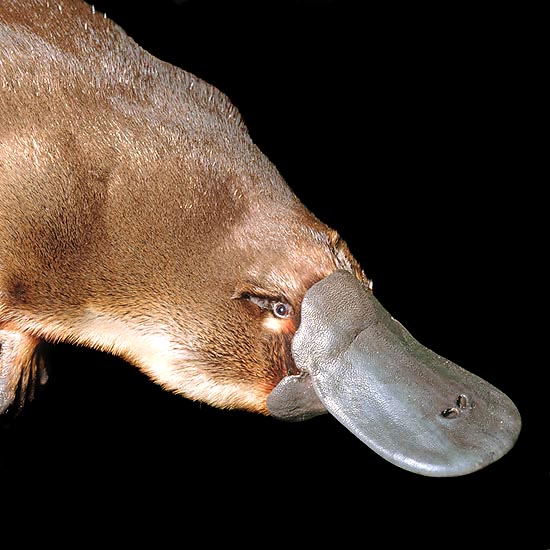
The beak of Ornithorhynchus anatinus has many nervous terminations © Giuseppe Mazza
Morphological, anatomical and physiological characteristics.
The Platypus (Ornithorhynchus anatinus Shaw, 1799) has a short and flat body and a dense waterproof fur, of a dark brown colour on the back and yellowish on the belly, on the whole body, but the feet and snout. The fur covers also eyes and ears (which lack of the ear-lap).
The tail is mainly formed by a fat tissue which is utilized for storing the fat reserves, exploited by the animal in winter or during periods with scarcity of food. Long up to 10-15 cm, it recalls the beaver’s one, but it differs from the same either for the shape or its utilization. As a matter of fact, the tail of the beaver, flat and broad, is utilized for proceeding in the water, whilst the platypus utilizes it and the back limbs only for changing direction, as the fore legs are dedicated to the propulsion in water.
The feet are short, with five toes provided with long claws and the front ones are palmate. The gait on the dry land is reptilian (the legs are placed on the sides of the body).
Adult males are on the average a third bigger than the females (about 50 cm of length and 2 Kg of weight). They show, on each one of the back legs, and more precisely on the heel, a corneous spur long about 1,5 cm. This spur is hollow and connected, through a duct, with a venomous gland. The young females hold an elementary specimen of this gland, which is however lost during their first year of life. Also the echidna has rudimentary spurs, and non-working venomous (crural) glands. The snout of the platypus, provided with two nostrils, is somewhat flexible (like the one of a duck), soft, rubbery and very sensible to the touch. This characteristic is due to the presence of several nervous terminations. The snout is utilized by the animal while looking for food and for orienting under the water. The animal is not furnished of teeth (which are however present in the new born) and grinds the food thanks to the sharp plaques which stand inside its mouth.
The platypus is equipped with a specialized sensorial system for perceiving the presence of preys under the water. It is based on the interception of electrical fields emitted by the metabolic activities of the preys. It is their bill which is furnished with a set of electro-receptors placed in rostrum-caudal lines and with mechanical receivers uniformly spread all over its length. The electro-sensorial area of the cerebral cortex is contained inside the tactile somato sensory area and some cortical cells receive signals either from the electro-receptors or the mechanical receptors, thus suggesting a strict connection between tactile sense and electrical one.
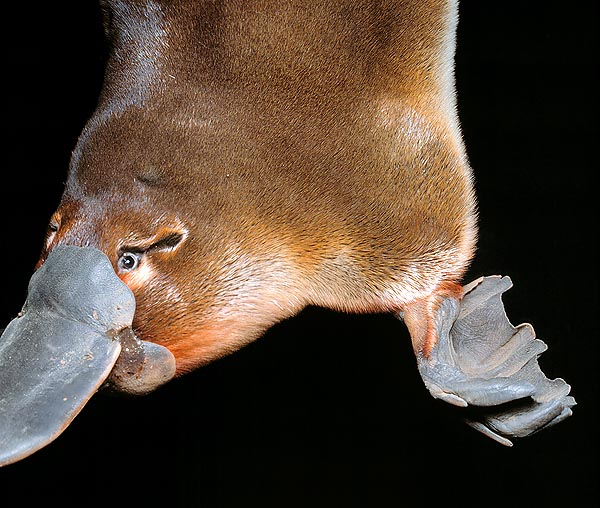
The palmate fore paws are the same for both sexes © Giuseppe Mazza
As said before, while looking for food, the platypus utilizes mainly the bill with which it sounds the bottom of the water-courses. It is possible that the electro receptors may be utilized also for distinguishing living objects from inanimate ones. Nevertheless, the system of electro-localization of the platypus still has many obscure sides and might require deeper researches. As to other mammals, it has a rather low metabolism and its average body temperature is lower than the others (32°C).
Ecology and behaviour
The platypuses are semi-aquatic night animals, excellent swimmers, which live in rivers, lakes and streams of almost all Australia and Tasmania, even if they are much more common in the south-eastern part of the Australian continent, where river floods, which harm their nests, do happen less frequently, or where is less common the presence of crocodiles (for which they are easy preys).
They are rather lonely animals, with specific territories where they live and feed. The territory of a platypus can be superposed to another’s one, but it does not seem that fights take place for its control.
It builds up two different kinds of dens: dens for living and nest ones. Whiles the first ones are utilized by both sexes for eating and sleeping, the second ones, more complicated, are utilized by the mothers for breeding the cubs.
The nest-dens can be up to 7 metres tall and 18 long and are furnished of either under water or surface entrances. During the mating time the female closes the entrances of the den each time it goes in and out, the cubs remain in the nest for about three months. The nest-dens are probably provided of a surface entrance either for allowing the entrance of oxygen or for protecting the kids from the floods.
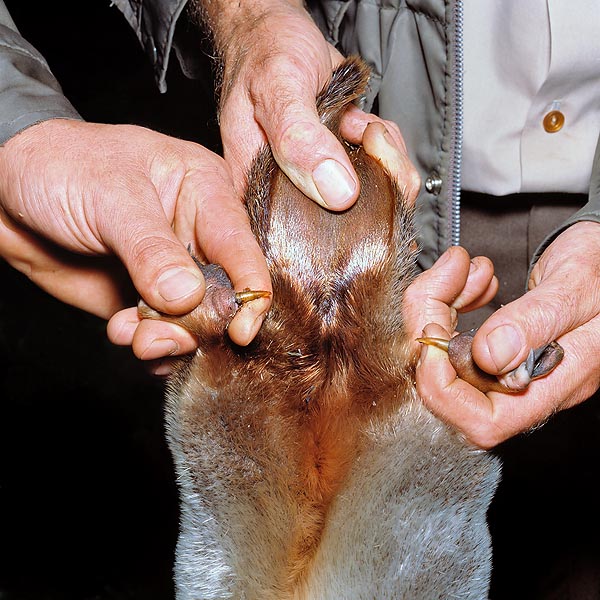
The male's back ones have as extra a venomous spur © Giuseppe Mazza
The platypus usually gets out during the night looking for food.
It is carnivorous and its diet includes invertebrates (crustaceans, earthworms, insects), eggs of fishes and amphibians and small vertebrates (fishes, frogs, tadpoles).
During the summer, it feeds more abundantly than in winter, accumulating the exceeding reserves in the tail as fat.
The research of the food happens during immersions in the bottom of the rivers, utilizing the head and the bill for removing the mud.
The immersions last about 40 seconds and during this time the platypus utilizes, in order to localize the preys, either the touch or its capacity of perceiving variations of the electrical fields (thanks to the nervous terminations of the bill of which we have already been talking).
Once seized the prey, the same is moved into the cheek-pouch, which is placed behind the bill, then the platypus reaches the surface and the food is moved to the mouth, where it is broken in tiny bits by the grinding plaques located in the maxilla and in the mandible. Some indented points are placed on the sides of the maxilla and are utilized for expelling the wastes (shells, mud, etc.).
Reproduction
The sexual maturity takes place when two years old. Before this time, the males do not produce any semen and the females lay eggs in a desultory way. The mating season stands between the months of July and August. Courting begins in water. Usually, the female takes the initiative, the two swim very close and also the mating happens in water. The pregnancy lasts about 2-3 weeks. The female does not deliver alive offspring, but lays eggs in a nest. Normally, a female lays two eggs. They are incubated by the mother for about 10 days in a chamber located in the bottom of the nest den.
The young, hairless, measure about 18 mm at their birth; they remain in the den, nourishing with their mother’s milk, for 3 or 4 months. Also after getting out, they go on in feeding with the maternal milk for some time, till when they are able to get their food autonomously.
The maternal body produces a sort of “milk” (without lactose).
It is given to the young through two structures, similar to dugs, placed on the abdomen and surrounded by hair. The new born, when pressing on these areas, cause the exit of the “milk”, which drains along the hair and is then licked up by them.
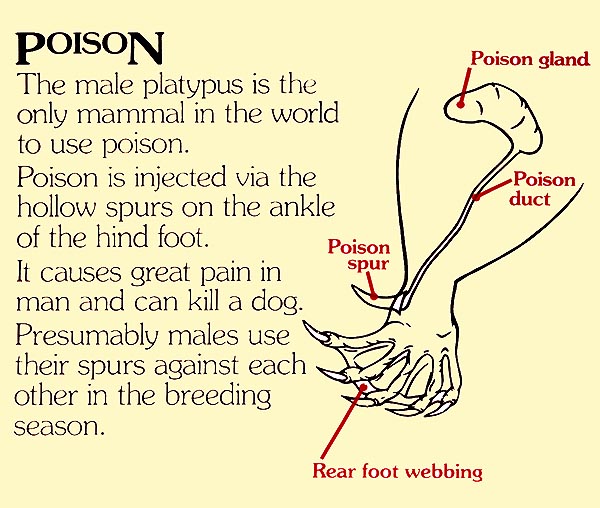
As this Healesville Sanctuary notice says the spur is connected to a venom gland
Also the genetic analysis of the platypus has shown that this animal is a composition of characteristics, much more complex than what it was thought (Grützner et al., 2003).
The species should have separated from the common ancestor it holds with the human species about 170 millions of years ago. It has been discovered recently that it holds 10 sexual chromosomes (10X in the female and 5X and 5Y in the male) (Waters et al., 2005).
The researchers have been looking in the genome of the Ornithorhynchus either for the DNA sequences belonging only to the monotremes as well as for those present in other vertebrates, thus discovering that some of its genetic sequences are more similar to those found in the birds than to those present in the Mammals (Grützner & Graves, 2004, Rens at al., 2007).
For instance, the chromosome DMRT1, which is under study since time by the geneticists because it seems to be determining the sex in the birds (system WZ), is found, almost identical, also in the platypus.
This has led to think that the appearance of the sexes has not happened separately in Birds and Mammals, but that a part of this differentiation is common to both.
The venomous apparatus of the Platypus: structure and function
The venomous apparatus, or crural system of the platypuses is limited to the males. It consists of a couple of hollow horny and mobile spurs, one for each back lag, placed at the level of the heel. Each spur is surrounded by muscles and is stuck, with its base, on an articulation which allows it to stand up, when necessary. At the base of the spur there is a reservoir from which departs a thin duct which runs through it. The central duct of the spur of an adult male platypus has a diameter of about 0,2 mm (Whittington et al., 2009).
Wide ducts go through the biceps, connecting the reservoirs to the venomous glands (alveolar, kidney shaped). When the male attacks a rival, it raises its spurs and thrusts them in the flesh of the victim; the venom is inoculated through repeated injections and, during each assault, even 4 ml of venom can be injected (Whittington et al., 2009). In the past, the hypothesis made about the function of the spurs and of the secretions of the femoral glands have been many.
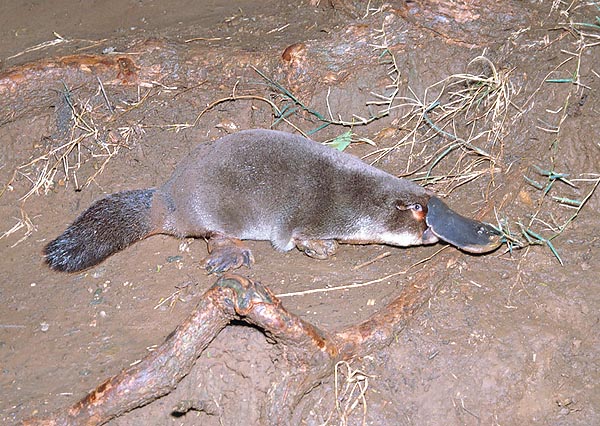
The gait on the ground is clumsy and reptilian © Giuseppe Mazza
The spurs can be utilized as defence for opposing to potential plunderers (such as crocodiles, birds of prey, Tasmanian devils, etc. …) but, during the mating period, they represent also a very good offensive system for overwhelming the other males of the same species. The prevailing hypothesis, already expressed by Martin and Tidswell (1895), was that, being present only in the male adult specimens, the spurs and the venom glands had to be connected with operations of sexual selection.
The ascertainment that the platypus has few natural enemies is the proof that here is a close relation between the secreting activity of the femoral glands and the reproduction; during the reproductive time, in fact, the venom gland increases in shape, the quantity of venom produced increases and at the same time the size of the testicle increases (Temple-Smith, 1973; Grant and Temple-Smith, 1998; Torres and Kuchel, 2000): this would back the idea that the crural system has evolved for getting a reproduction function.
The rivals poisoning should confer an advantage to the prevailing males: the injection of the venom, causing pain and hampering the locomotion, should allow the prevailing male to mate freely, without any fighting. Normally, the poisoning of a platypus by another male is not mortal. The clinical manifestations of a poisoning caused by a platypus have been related in few works.
The first documented cases of human poisoning go back to the end of 1800 (Martin and Tidswell, 1895), but the description of the first clinical case dates only from 1992 (Fenner et al., 1992). In this work are described the main symptoms of the poisoning which are oedema and immediate, sharp pain which does not subside even with morphine, and which lasts several months (Fenner et al., 1992). Laboratory haematological tests have shown an increase of erythro-sedimentation speed, indicating a possible coagulopaty, it looks like, anyway, that there are no evidences of neurotoxicity, myotoxicity or necrotizing effects. Fatal cases for the man have never been reported. Similar symptoms (pain and oedema) have been related also by subsequent authors (Tonkin and Negrine, 1994).
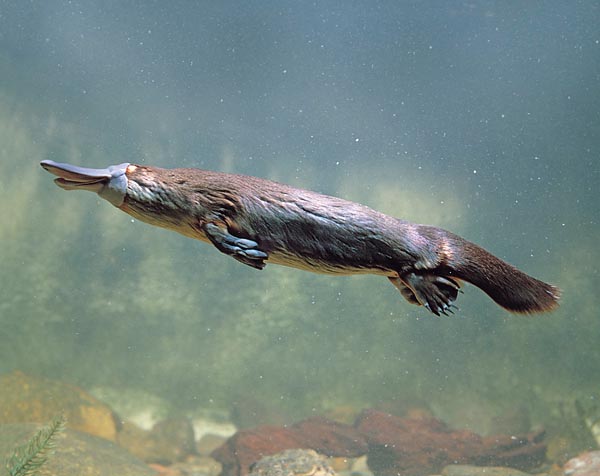
Conversely, in water it is very agile and feels the electrical fields made by the preys © Giuseppe Mazza
The knowledge of the substances composing the venom of the platypus is still scarce. Few are the researches done until now in this field and additional researches are difficult to be realized, owing to the problems connected with the obtainment of the poison and of samples of tissues.
The poison of the platypus is a rather complex substance. The unusual nature of the poisoning symptoms might lead to think to a complex mixture of very different peptides and proteins, some of which still unknown (de Plater et al., 1995; Whittington and Belov, 2007).
The first experiments done on the secretion of the crural glands have shown that the venom caused, in the rabbits, via subcutaneous injection, important oedema and quick decrease of the arterial pressure (A.P.), breathing difficulties and death, if injected intravenously. During the Nineties, the availability of new techniques for the characterization has enabled to identify with accuracy some components of the venom of the platypus.
In some studies, it has been demonstrated the effect of the venom on the smooth muscles, thus causing the assumption of the presence, in its interior, of a natriuretic peptide (de Plater et al., 1995; 1998 a, b). The natriuretic peptides are a family of peptides which did highly conserve in the different species and seem to control the blood pressure.
It has been recently discovered that the venom consists of at least 19 different peptide sequences (Whittington and Belov, 2007), together with non-protein components (probably prostaglandins). Presently, however, only three peptides have been identified and placed in sequence, even if their exact functions are not yet precisely known. They are: type C (CNPs) natriuretic peptides; defensive-like peptides (DLPs); nerve growth factor (NGFs).
Synonyms: Ornithorhynchus brevirostris Ogilby, 1832; Ornithorhynchus crispus MacGillivray, 1827; Ornithorhynchus fuscus Péron, 1807; Ornithorhynchus laevis MacGillivray, 1827; Ornithorhynchus novaehollandiae Lacépède, 1800;
Ornithorhynchus paradoxus Blumenbach, 1800; Ornithorhynchus phoxinus Thomas, 1923; Ornithorhynchus rufus Péron, 1807; Ornithorhynchus triton Thomas, 1923.
